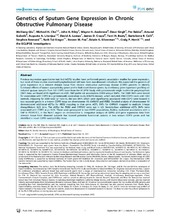Genetics of Sputum Gene Expression in Chronic Obstructive Pulmonary Disease
Qiu, Weiliang; Cho, Michael H.; Riley, John H.; Anderson, Wayne H.; Singh, Dave; Bakke, Per; Gulsvik, Amund; Litonjua, Augusto A.; Lomas, David A.; Crapo, James D.; Beaty, Terri H.; Celli, Bartolome R.; Rennard, Stephen I.; Tal-Singer, Ruth; Fox, Steven M.; Silverman, Edwin K.; Hersh, Craig P.
Peer reviewed, Journal article
Published version

View/
Date
2011-09-16Metadata
Show full item recordCollections
Original version
https://doi.org/10.1371/journal.pone.0024395Abstract
Previous expression quantitative trait loci (eQTL) studies have performed genetic association studies for gene expression, but most of these studies examined lymphoblastoid cell lines from non-diseased individuals. We examined the genetics of gene expression in a relevant disease tissue from chronic obstructive pulmonary disease (COPD) patients to identify functional effects of known susceptibility genes and to find novel disease genes. By combining gene expression profiling on induced sputum samples from 131 COPD cases from the ECLIPSE Study with genomewide single nucleotide polymorphism (SNP) data, we found 4315 significant cis-eQTL SNP-probe set associations (3309 unique SNPs). The 3309 SNPs were tested for association with COPD in a genomewide association study (GWAS) dataset, which included 2940 COPD cases and 1380 controls. Adjusting for 3309 tests (p,1.5e-5), the two SNPs which were significantly associated with COPD were located in two separate genes in a known COPD locus on chromosome 15: CHRNA5 and IREB2. Detailed analysis of chromosome 15 demonstrated additional eQTLs for IREB2 mapping to that gene. eQTL SNPs for CHRNA5 mapped to multiple linkage disequilibrium (LD) bins. The eQTLs for IREB2 and CHRNA5 were not in LD. Seventy-four additional eQTL SNPs were associated with COPD at p,0.01. These were genotyped in two COPD populations, finding replicated associations with a SNP in PSORS1C1, in the HLA-C region on chromosome 6. Integrative analysis of GWAS and gene expression data from relevant tissue from diseased subjects has located potential functional variants in two known COPD genes and has identified a novel COPD susceptibility locus.
